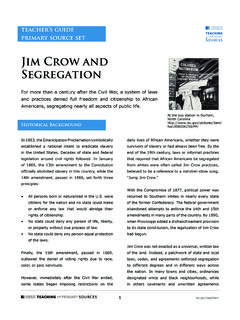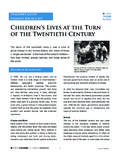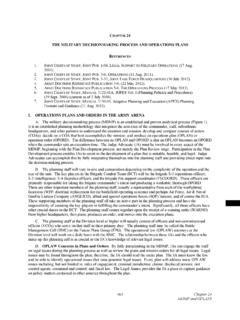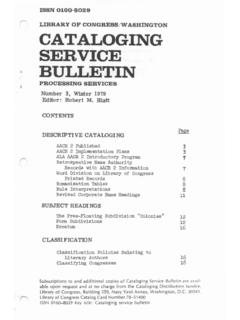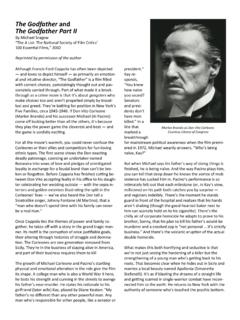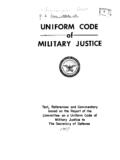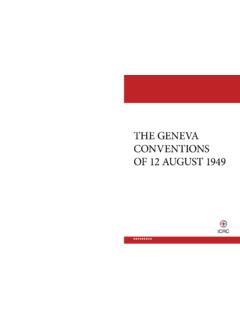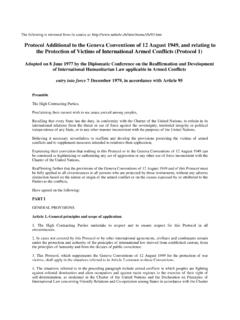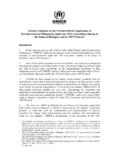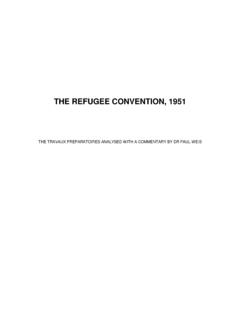Transcription of GENEVA CONVENTION III: PRISONERS OF WAR - loc.gov
1 GENEVA CONVENTION III: PRISONERS OF WAR I. OBJECTIVES A. Become familiar with the historic influences on the development of protections for PRISONERS of war (POWs) during periods of armed conflict. B. Understand the legal definition of prisoner of war, and the test for determining when that status is conferred. C. Understand the basic protections, rights, and responsibilities afforded to PRISONERS of War. II. HISTORY OF PRISONERS OF WAR A. In ancient times, the concept of prisoner of war 1 was unknown and the defeated became the victor s chattel. 2 The captive could be killed, sold, or put to work and the discretion of the captor. No one was as helpless as an enemy prisoner of B. Greek, Roman, and European theologians and philosophers began to write on the subject of POWs.
2 However, treatment of POWs was still by and large left to military C. The American War of Independence. For the colonists, it was a revolution. For the British, it was an insurrection. The British, saw the colonists as the most dangerous of criminals, traitors to the empire, and threats to state survival. The British, 1 See WILLIAM FLORY, PRISONERS OF WAR: A STUDY IN THE DEVELOPMENT OF INTERNATIONAL LAW (1942) (providing a more detailed account of prisoner of war treatment through antiquity). 2 COMMENTARY: III GENEVA CONVENTION RELATIVE TO THE TREATMENT OF PRISONERS OF WAR 4 (Jean S. Pictet ed. 1952). 3 Probably the most famous medieval prisoner of war was England's Richard I of Robin Hood fame. King Richard's ship sank in the Adriatic Sea during his return from the Third Crusade in 1192. While crossing Europe in disguise, he was captured by Leopold, Duke of Austria. Leopold and his ally, the Holy Roman Emperor, Henry VI, entered into a treaty with Richard on St.
3 Valentine's Day, 1193, whereby England would pay them 100,000 in exchange for their king. This amount then equaled England's revenues for five years. The sum was ultimately paid under the watchful eye of Richard's mother, Eleanor of Aquitaine, and he returned to English soil on March 13, 1194. See M. Foster Farley, PRISONERS for Profit: Medieval Intrigue Quite often Focused upon Hopes of Rich Ransom, MIL. HISTORY, Apr. 1989, at 12. Richard s own confinement did seem to ingrain some compassion for future PRISONERS of war he captured. Richard captured 15 French knights in 1198. He ordered all the knights blinded but one. Richard spared this knight one eye so he could lead his companions back to the French army. This was considered an act of clemency at the time. MAJOR PAT REID, prisoner OF WAR (1984). 4 See generally, Rev. Robert F. Grady, The Evolution of Ethical and Legal Concern for the prisoner of War, 1-30 (1970) (unpublished Ph. D. dissertation, Cath.)
4 Univ.) (on file with the TJAGLCS library) [hereinafter Grady]. 67 GENEVA CONVENTION III therefore, prepared to try colonists for treason at the war s onset. In time however, British forces begrudgingly recognized the colonists as belligerents and this plan was discarded. However, colonists that were captured were subjected to inhumane treatment and neglect. There were individual acts of mistreatment by American forces of the British and Hessian captives; however, General Washington appears to have been sensitive to the welfare of POWs. He took steps to prevent D. The first agreement to establish prisoner of war (POW) treatment guidelines was likely found in the 1785 Treaty of Friendship between the and E. American Civil War. At the outset, the Union forces did not view the Confederates as professional Soldiers deserving protected status.
5 They were considered nothing more than armed insurrectionists. As southern forces began to capture large numbers of Union PRISONERS , it became clear to Abraham Lincoln that his only hope for securing humane treatment for his troops was to require the proper treatment of Confederate soldiers. President Lincoln issued General Order No. 100, Instructions of the Government of Armies of the United States in the Field, known as the Lieber Code. The Lieber Code provided several protections for Confederate PRISONERS . 1. Although the Lieber Code went a long way in bringing some humanity to warfare, many traditional views regarding POWs prevailed. For example, Article 60 of the Code provides: a commander is permitted to direct his troops to give no quarter, in great straits, when his own salvation makes it impossible to cumber himself with PRISONERS . 7 2. Confederate policy called for captured black Soldiers to be returned or sold into slavery and for white Union officers serving with black troops to be prosecuted for exciting servile insurrection.
6 8 Captured black Soldiers that could not prove they were free were sold into slavery. Free blacks were not much better off. They were treated like slaves and forced to perform labor to support the Confederate war effort. In response to this policy, Article 58 of the Lieber Code stated that the Union would take reprisals for any black POWs sold into slavery 5 JOHN C. MILLER, TRIUMPH OF FREEDOM (1948); REV. R. LIVESAY, THE PRISONERS OF 1976; A RELIC OF THE REVOLUTION COMPILED FROM THE JOURNAL OF CHARLES HERBERT (1854); SYDNEY GEORGE FISHER, THE STRUGGLE FOR AMERICAN INDEPENDENCE (1908). 6 See HOWARD S. LEVIE, 60 INTERNATIONAL LAW STUDIES, DOCUMENTS ON PRISONERS OF WAR 8 (1979) [hereinafter Levie, DOCUMENTS ON PRISONERS OF WAR] (providing additional test interpreting the Third GENEVA CONVENTION ). 7 See id. at 39; George B. Davis, Doctor Francis Lieber s Instructions for the Government of Armies in the Field, 1 AM. J. INT L L. 13 (1907) (providing a summary of who Doctor Francis Lieber was and the evolution of the Lieber Code).
7 8 VOL. V, THE WAR OF THE REBELLION: A COMPILATION OF THE OFFICIAL RECORDS OF THE UNION AND CONFEDERATE ARMIES AT 807-808 (Gov. Printing Office 1880-1901). GENEVA CONVENTION III 68 by executing Confederate Very few Confederate PRISONERS were executed in reprisal. However, Confederate Soldiers were often forced into hard labor as a 3. The Union and Confederate armies operated a parole or prisoner exchange The Union stopped paroling southern Soldiers for several reasons, most notably its significant numerical advantage. It was fighting a war of attrition and POW exchanges did not support that effort. This Union decision may have impacted on the poor conditions in southern POW camps because of the additional strain on resources at a time when the Confederate army could barely sustain itself. Some historians point out that the Confederate POW guards were living in conditions only slightly better than their Union 4.
8 Captured enemy have traditionally suffered great horrors as POWs. Most Americans associate POW maltreatment during the Civil War with the Confederate camp at Andersonville. However, maltreatment was equally brutal at Union camps. In the Civil War 26,486 Southerners and 22,576 Northerners died in POW 5. Despite its national character and Civil War setting, the Lieber Code went a long way in influencing European efforts to create international rules dealing with the conduct of war. F. The first multilateral international attempt to regulate the handling of POWs occurred in 1907 with the promulgation of the Hague Regulations Respecting the Laws and Customs of War on Land (HR). Although the HR gave POWs a definite legal status and protected them against arbitrary treatment, the Regulations were primarily concerned with the methods and means of warfare rather than the care of the victims 9 Francis Lieber, War Department, Instructions for the Government of Armies of the United States in the Field art.
9 58 (1863) [hereinafter Lieber Code], reprinted in The Laws Of Armed conflicts 3 (Dietrich Schindler & Jiri Toman eds., 3d rev. ed. 1988). 10 George G. Lewis & John Mewha, Dep t of the Army, Pamphlet No. 20-213: History of prisoner of War Utilization by the United States Army 1776-1945 (1955). 11 The Dix-Hill Cartel was signed and ratified by both sides on the Civil War on July 22, 1862. It lasted until 1863, failing primarily because of Confederate refusals to parole black POWs, and the rapid return parolees to the battlefield. See HENRY P. BEERS, THE CONFEDERACY, GUIDE TO THE ARCHIVES OF THE GOVERNMENT OF THE CONFEDERATE STATES OF AMERICA 234 (GSA 1986). 12 REV. J. WILLIAM JONES, CONFEDERATE VIEW OF THE TREATMENT OF PRISONERS (1876). 13 Over one-half of the Northern POWs died at Andersonville. See Lewis L. Laska & James M. Smith, Hell and the Devil : Andersonville and the Trial of Captain Henry Wirz, , 1865, 68 MIL. L. REV. 77 (1975).; See also SANITARY COMMISSION, NARRATIVE OF PRIVATIONS AND SUFFERINGS OF UNITED STATES OFFICERS AND SOLDIERS WHILE PRISONERS OF WAR IN THE HANDS OF THE REBEL AUTHORITIES, S.
10 REP. NO. 68 (3d Sess. 1864), for a description of conditions suffered by POWs during the Civil War. FLORY, supra note 1, at 19, n. 60 also cites the Confederate States of America, Report of the Joint Select Committee Appointed to Investigate the Condition and Treatment of PRISONERS of War (1865). 69 GENEVA CONVENTION III of war. Moreover, the initial primary concern was with the care of the wounded and sick rather than G. World War I. The Hague Regulations proved insufficient to address the treatment of the nearly 8,000,000 POWs taken in WWI. Germany was technically correct when it argued that the Hague Regulations were not binding because not all participants were According to the regulations, all parties to the conflict had to be signatories if the Regulations were to apply to any of the parties. If one belligerent was not a signatory, then all parties were released from mandatory compliance.

